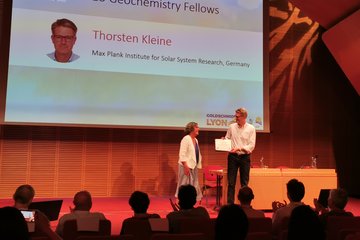Alle Typen
221.
Konferenzbeitrag
New results from midlatitude E-region coherent backscatter obtained with SESCAT. In: Plasma Instabilities in the Ionospheric E-Region. Proc. of Workshop in Katlenburg-Lindau 1995, S. 27 - 30 (Hg. Schlegel, K.). Cuvillier, Göttingen (1996)
222.
Konferenzbeitrag
Computer experiments on the nonlinear saturation of the modified two-stream instability. In: Plasma Instabilities in the Ionospheric E-Region. Proc. of Workshop in Katlenburg-Lindau 1995, S. 95 - 98 (Hg. Schlegel, K.). Cuvillier, Göttingen (1996)
223.
Konferenzbeitrag
Der Schwerewellen-TID Zusammenhang - Ein ``Lehrstück'' der Natur zur Physik der Thermosphären-Ionosphären Wechselwirkung. In: Kleinheubacher Berichte, S. 429 - 438. (1994)
224.
Konferenzbeitrag
Plans for an EISCAT polar cap radar. In: Proc. of a meeting of the Nordic Society for Space Research (NSSR) at Bolkesjö Hotel, Norway, S. 133 - 138. Norwegian Space Centre, Oslo, Norway (1991)
225.
Konferenzbeitrag
Ionospheric radio and propagation. In: Activities in Radio Science in the Federal Republic of Germany 1987-1989, S. G1 - G11. (1990)
226.
Konferenzbeitrag
Atmospheric gravity waves in the auroral source region of TIDs studied with the EISCAT CP2-data. In: Ionospheric Structure and Variability on a Global Scale and Interactions with Atmosphere and Magnetosphere, S. 28-1-28-13. AGARD, Neuilly sur Seine, France (1989)
227.
Konferenzbeitrag
Global morphology of plasma bubbles in the low latitude ionosphere. In: Ionospheric Structure and Variability on a Global Scale and Interactions with Atmosphere and Magnetosphere, S. 8-1-8-6. (1989)
228.
Konferenzbeitrag
Recent progress in the study of two stream plasma instability in the high latitude E-region. In: Proceedings of the International Symposium on Polar Geomagnetic Phenomena, Electrodynamical Processes in High Latitudes, Souzdal, USSR, May 25-31, 1986. (1988)
229.
Konferenzbeitrag
CAESAR investigations. In: Proceedings of the 8th ESA Symposium on European Rocket and Balloon Programmes and Related Research, Sunne, Sweden, 17-23 May 1987, S. 299 - 303. ESA Publ. Div., Noordwijk (1987)
230.
Konferenzbeitrag
Remote and in-situ plasma measurements during the CAESAR flight. In: Proceedings of the 8th ESA Symposium on European Rocket and Balloon Programmes and Related Research, Sunne, Sweden, 17-23 May 1987, S. 315 - 318. ESA Publ. Div., Noordwijk (1987)
231.
Konferenzbeitrag
Plasma instabilities in the auroral E-region. In: Proceedings of the 7th ESA Symposium on European Rocket & Balloon Programmes and Related Research, Loen, Norway, 5-11 May, 1985, S. 89 - 94. ESA Publ. Div., Noordwijk (1985)
232.
Konferenzbeitrag
Ionospheric radio. In: Activities in Radio Science in the Federal Republic of Germany 1981-1983, Report to U. R. S. I., XXIth General Assembly, Florence, Italy, August/September 1984, S. G1-G-15. DFG Deutsche Forschungsgemeinschaft (1984)
233.
Konferenzbeitrag
Partial reflection studies in the quiet polar D-region with respect to mesospheric turbulence parameters. In: Proceedings of Dynamical and Chemical Coupling between the Neutral and Ionized Atmosphere, S. 253 - 259 (Hg. Grandal, B.; Holtet, J. A.). D. Reidel Publ. Comp, Dordrecht-Holland (1977)
234.
Konferenzbeitrag
Mesosphere-Thermosphere-Ionosphere Coupling. In: Symposium of present and future scientific programmes of the Max-Planck-Institut für Aeronomie. ANY PUBLISHER, Lindau/Harz (1973)
235.
Bericht
A new Fabry-Perot interferometer experiment for neutral atmosphere studies in conjunction with the EISCAT incoherent-backscatter radar system. Max-Planck-Institut für Aeronomie, Katlenburg-Lindau, Germany (1997)
236.
Bericht
The EISCAT SVALBARD Radar. Rutherford Appleton Laboratory, Chilton, Didcot, UK (1991)
237.
Bericht
Interplanetary magnetic field polarity changes and D-region radio wave absorption. Max-Planck-Institut für Sonnensystemforschung, Katlenburg-Lindau, Germany (1976)
238.
Sonstige
Electron temperatures in the high latitude topside ionosphere from satellite and incoherent scatter data, ISAS Research Note 395, (1988)
239.
Sonstige
Forschungsschwerpunkt "Untere Atmosphäre", (1974)











